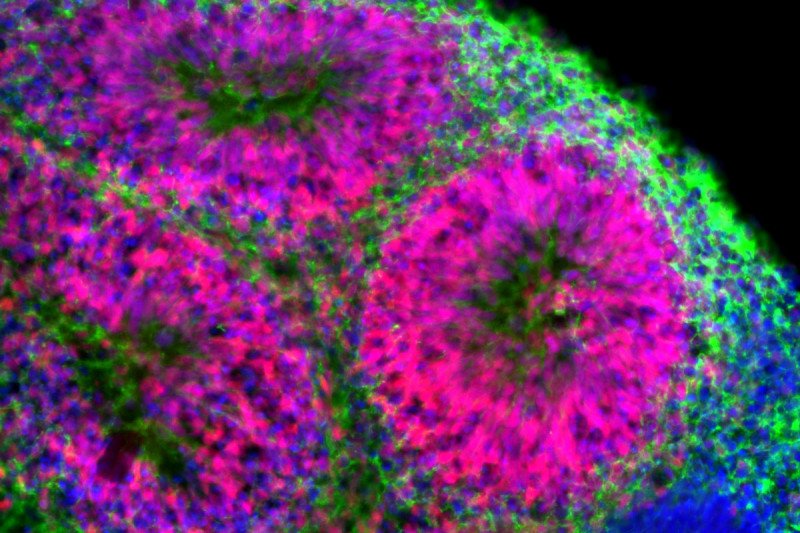
This image shows an organoid that mimics a developing brain. The red and green colors identify proteins that are characteristic of developing brain cells. The blue color denotes DNA.
Over the past few years, thousands of babies whose mothers were infected with the mosquito-borne virus Zika have been affected by a devastating birth defect called microcephaly, in which the head and brain are small and don’t develop properly. Although the virus has been known for decades, public outcry for a vaccine or treatment grew louder in 2015 and 2016 as the virus spread.
Now investigators from Memorial Sloan Kettering and Weill Cornell Medical College are using a combination of tools in the lab — including mouse models and tiny stem cell–derived, brain-like structures called organoids — to identify drugs that could either prevent Zika infection or treat ongoing infections.
An Infection that Acts on Stem Cells
Zika is transmitted by certain species of mosquito that live mostly in tropical areas. The virus rarely causes symptoms, and even when it does, they are usually mild. But it can have a tremendous negative impact on brain growth in fetuses. Studies published earlier this year indicated that Zika does its damage by altering the growth of neural stem cells in the developing brain.
For many years, the lab of MSK developmental biologist Lorenz Studer has used human pluripotent stem cells to study the growth and development of specialized subtypes of brain cells. Pluripotent stem cells, which may be derived from embryos or from adult cells, have the potential to grow into any type of cell in the body. The majority of Dr. Studer’s work is focused on different types of neurons. His research has implications for treating neurological disorders such as Parkinson’s disease, as well as for repairing brains damaged by cancer or cancer treatment.
“The idea of studying the Zika virus was driven by Shuibing Chen, our longstanding collaborator at Weill Cornell,” Dr. Studer says. “She realized that her lab’s expertise in drug discovery and our lab’s expertise in studying brain organoids and neural stem cells could address a major unmet need in developing effective drug candidates for Zika.” He and Dr. Chen are co-senior authors of a paper being published in Cell Stem Cell.
Screening for Drugs
In the new study, the investigators used embryonic stem cells to make a type of cell called a human cortical neuron progenitor cell (hNPC), which gives rise to many types of cells in the brain. They used the hNPCs to test various chemicals that might inhibit Zika infection. They identified two drug candidates that have this effect: hippeastrine hydrobromide (HH) and amodiaquine dihydrochloride dihydrate. Both compounds were able to suppress the Zika virus to undetectable levels and appeared to have no toxic effects on the hNPCs themselves.
The team then tested these compounds using organoids developed by Gustav Cederquist, an MD/PhD student in Dr. Studer’s lab and co-first author of the paper. Organoids are miniature organs made from stem cells and grown in a dish, in this case to resemble the fetal brain. “Organoids are particularly useful to assess potential drug toxicities during fetal development,” Mr. Cederquist says.
Dr. Studer adds that they can be produced in large numbers for lab experiments, and that they represent a stage of human brain development that would otherwise be completely inaccessible to us and thus very difficult to study.
The organoids were infected with Zika, and their development was studied for more than two weeks. The untreated organoids showed significantly decreased growth — very similar to what is seen in Zika-infected fetal brains — compared with the organoids that had been given one of the drugs after infection. In particular, treatment with HH was able to rescue the organoids from the defects that are associated with Zika, even after they had an established infection. This is the first time such a benefit has been shown for any drug, Dr. Studer explains.
Taking the Research into Animal Models
In a third set of experiments, the investigators tested the compounds on Zika-infected mice. “This type of testing is critical prior to considering the use of these new drug candidates in people,” he says. “Things that initially appear to be promising drugs may work very differently in living animals than they do in a dish.”
He adds that their research showed HH appears to be particularly effective at both preventing the infection from taking hold in mice and at treating infections that are already established.
“A very important question to ask is who would benefit most from the drug,” he concludes. “Options would be to give the drug to people who are at high risk of infection, people who are likely already infected, or people with symptoms and confirmed infection.” And because the fetus would be one of the “true” patients, he adds, it’s vital to confirm that any candidate drug would be safe during pregnancy.
The researchers will continue with efforts to develop HH and other related drugs into treatments for Zika. Dr. Studer explains that because the screening and organoid technology works so well, they could widen their search to look for additional compounds that treat Zika virus or even other infectious diseases that affect the brain.





